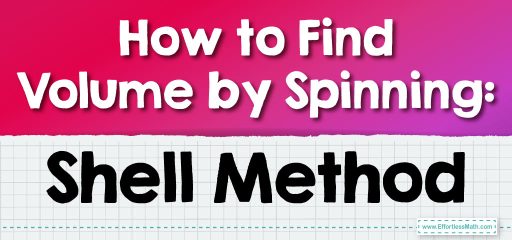How to Find Volume by Spinning: Shell Method
The Shell Method calculates volumes of solids of revolution by integrating cylindrical shells' circumferences. It's particularly effective when the axis of rotation is parallel to the y-axis, simplifying calculations for solids with complex shapes. This method sums the volumes of concentric cylindrical shells, derived from rotating a function around an axis, offering an alternative approach when the Disk or Washer Methods are less practical.

Beyond handling typical revolution solids, the Shell Method shines in scenarios where internal structures vary significantly, like in hollow or layered objects. Its adaptability to both horizontal and vertical axes of rotation makes it a versatile tool in engineering and architectural design, enabling precise volume estimations for objects like pipes within walls or tunnels through hills. By focusing on the lateral surface area of thin shells, it also facilitates understanding material requirements for manufacturing and construction, bridging theoretical calculus with practical applications in material science and mechanical engineering.
For a solid generated by revolving a region around the y-axis, the Shell Method’s mathematical approach involves:
- Identify the Function: Consider a function \( f(x) \) defined on the interval \([a, b]\).
- Define Shell Radius and Height: The radius of each shell is \( x \), and the height is given by \( f(x) \).
- Shell Volume Formula: The volume of a thin shell is approximated by the circumference of the shell \((2\pi x)\) times its height \((f(x))\) times its thickness \((dx)\).
- Set Up the Integral: The total volume \(V\) is the integral of the shell volume formula over the interval \([a, b]\):
\( V = \int_{a}^{b} 2\pi x f(x) \, dx \)
Let’s calculate the volume of the solid formed by revolving the region between the curve \( y = \ln(x) \) and the x-axis, around the y-axis from \( x = 1 \) to \( x = e \) (where \( e \) is the base of the natural logarithm).
Step-by-Step Solution Using the Shell Method:
- Function and Interval:
- The function is \( y = \ln(x) \), defined from \( x = 1 \) to \( x = e \).
- Shell Radius and Height:
- Radius \(( r )\) of each cylindrical shell is the x-coordinate, \( x \).
- Height \(( h )\) of each shell is given by the function \( y = \ln(x) \).
- Volume of a Shell:
- The volume of each shell is \( 2\pi x \ln(x) \, dx \).
- Set Up the Integral:
- The total volume \( V \) is the integral of the shell volume from \( x = 1 \) to \( x = e \):
\( V = \int_{1}^{e} 2\pi x \ln(x) \, dx \)
- Evaluate the Integral:
To solve the integral (\int 2\pi x \ln(x) dx) using integration by parts, we’ll follow the integration by parts formula, (\int u \, dv = uv – \int v \, du), step by step:
- Choose \(u\) and \(dv\):
- Let \(u = \ln(x)\), which means \(du = \frac{1}{x} dx\).
- Let \(dv = 2\pi x dx\), which means \(v = \pi x^2\).
- Apply the Integration by Parts Formula:
- According to the formula, \(\int 2\pi x \ln(x) dx = uv – \int v \, du\).
- Substituting \(u\), \(du\), and \(v\) gives: \(\pi x^2 \ln(x) – \int \pi x^2 (\frac{1}{x}) dx\).
- Simplify the integral: \(\pi x^2 \ln(x) – \pi \int x dx\).
- Solve the Simplified Integral:
- The integral \(\int x dx) simplifies to (\frac{1}{2}x^2\).
- Therefore, the expression becomes \(\pi x^2 \ln(x) – \pi \frac{1}{2}x^2\).
- Evaluate from \(x = 1\) to \(x = e\):
- The final step involves evaluating the expression from \(x = 1\) to \(x = e\).
Let’s perform these calculations for the correct evaluation.
After performing the integration by parts and evaluating from \(x = 1\) to \(x = e\), the volume of the solid formed by revolving the region between \(y = \ln(x)\) and the x-axis around the y-axis is approximately \(13.18\) cubic units.
Related to This Article
More math articles
- The Ultimate OAA Algebra 1 Course (+FREE Worksheets)
- Top 10 Tips You MUST Know to Retake the FTCE Math Test
- Number Properties Puzzle – Challenge 22
- Line Plot
- How to Get a PhD in Math
- Mastering the Art of Integration: Vector-Valued Functions Explored
- ASVAB Math Formulas
- Logistic Models And Their Use: Complete Explanation, Examples And More
- FREE HSPT Math Practice Test
- How to Solve Multiplication Rule for Probabilities?





















What people say about "How to Find Volume by Spinning: Shell Method - Effortless Math: We Help Students Learn to LOVE Mathematics"?
No one replied yet.